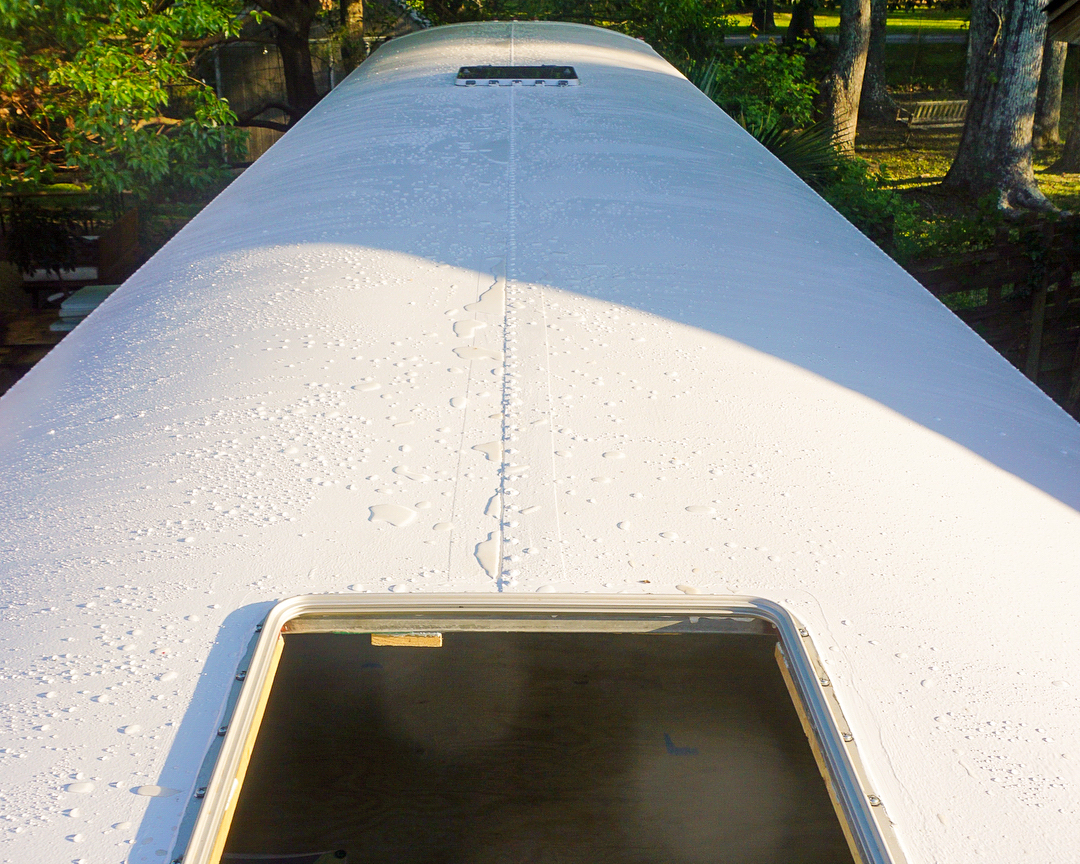Painting and Sealing Your Roof
Many new school bus owners will discover in dismay in the midst of the first torrential downpour that the roof of their future tiny home is leaking. Often it is just one or both of your emergency escape hatches. However sometimes it is the seams in the roof, or other roof penetrations or just simply everywhere! This is because school buses are typically topped with as many as 10 steel sheets which are sealed and riveted to the steel members below and over the years sealant at the seams and roof penetrations will fail.
The solution is simple: climb up on the roof, remove loose paint/sealant from seams and around penetrations with a steel brush, angle grinder with brush attachment, or a painter’s knife, reseal each seam and coat with a new paint/sealant.
The big question however is what products should you use? Well to start out with for seam sealing there are endless amounts of sealants/adhesives that advertise a wide array of uses, and many of them would do just fine on your bus roof, however the majority would be a horrible choice. For example the handyman’s go to: 100% silicone in this case would fail sooner than later as it does not react well to the constantly changing temperature of your roof, and it is not paintable, and nothing will stick to it. In this situation the Skoolie builder’s go to is probably Sikaflex 221 in white. This polyurethane adhesive/sealant remains flexible over a wide array of temperatures and is paintable when cured. Please know however that it is extremely messy and difficult to clean. Wear latex gloves, change them when necessary, and buy a can of mineral spirits for clean up, as water in this scenario is not your friend.
With your old sealant removed, your new sealant installed it is time to paint your roof. Now in all likelihood you will be happiest with a white roof. Your Skoolie’s roof will contribute immensely to solar heat gain as it basks in the sun and anything short of white will simply absorb too much heat and turn your home into a giant mobile oven. If you live in Alaska or another consistently cold climate feel free to ignore my advice and paint your whole bus black as solar heat gain may in fact be what you’re looking for! If you feel inclined to paint your bus roof a gentle color closely approximating white like perhaps a really light baby blue just don’t do it as anything short of white will reflect significantly less heat off of your roof.
At this point you now have to consider exactly which of the several products is right for your roof and your circumstances and your options are as follows: elastomeric paint such as Henry’s 287 Solar-Flex, a silicone roof coating such as Henry’s 887 Tropicool which is a product specially formulated for metal roofs in hot climates and does not behave the same as standard silicone sealant, or plain white exterior metal paint. If you plan to be in a colder climate with warm summer days than I recommend you pick an elastomeric paint, or even an exterior metal paint. The majority of the solar reflection will be accomplished with simply white paint alone. However the elastomeric paint has been intentionally formulated for a metal roof and is the best choice here unless your whole bus will be painted white and you’d like to skip the elastomeric coating for the sake of financial savings/ease.
In deciding between an elastomeric roof coating and a silicone roof coating once again climate is your main consideration. The silicone roof coating has been formulated for southern Florida metal roofs and will give you the absolute best in heat reflection. If you plan to be air-conditioning your skoolie in hot climates (this is something that we do in our bus) than a silicone roof coating is the choice for you. But there is a catch. The silicone roof is slightly textured and will actually hold dirt more than the elastomeric will, eventually negating the advantage it has over the elastomeric coating. If you are able to clean your roof frequently this is a moot point, however it is worth consideration. An advantage to the silicone roof coating is that it is extremely effective at sealing small leaks and after two coats will form a whole new rubber skin on top of your school bus impenetrable by standing water that will last a very long time. A disadvantage is that almost nothing will now stick to it, so future adhering/sealing is best done by a compatible silicone sealer made for sealing silicone roofs. Once again these formulations of silicone hold up better to temperature fluctuation than the residential household types.
In the end a white elastomeric roof paint will be the right choice for most builders in most climates which is nice because it is generally half as expensive as the silicone coating. If you won’t be spending summers in the Southeast or the dessert than the silicone roof coating is not worth the added expense and hassle.
Regardless of your choice before you apply the coating be sure to thoroughly clean your roof with a stiff brush and/or a pressure washer, seal seams before coating/painting and plan for a rain-free day to paint. Patiently tape off any areas that will not be painted, use a brush (that you don’t mind throwing away) to apply coating to the edges, and use a paint roller attached to a painter’s pole or a broom handle to liberally apply the coating. Two coats is a must. Three coats is even better. While we bought a 5 gallon bucket of roof sealant to do two coats, we probably would have gotten by with two 1 gallon cans and saved money. Once you’re finished, take a picture! Your roof now looks better than it ever will again. Congratulations: you did something on the bus!





0 Comments